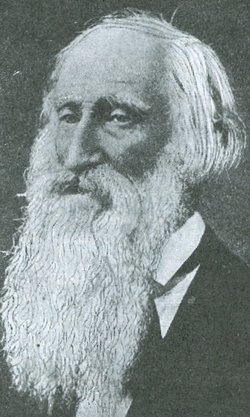|

January 6, 2020
#303
Please join us in congratulating and offering
our sincere appreciation for Barbara Schock's 300th+ Sandburg's Hometown
post on our Carl Sandburg Historic Site Association website!! Thank you,
Barbara, for sharing your extraordinary gift of these vignettes of Galesburg &
19th century American history.

Hiram H. Kellogg (1803-1881)
First President of Knox College |
H. H. Kellogg By Barbara
Schock
Hiram Huntington Kellogg died January 1, 1881, of
typhoid pneumonia in Cook County, Illinois. The Galesburg newspapers reported
the news a week later.
Kellogg had been born February 26, 1803, in the state of
New York. He married Mary G. Chandler October 13, 1827, in Clinton County, New
York. He became a clergyman and teacher and conducted a school for girls. The
young women were taught liberal arts as well as management of the home. Unusual
for the time, black girls were included in the student body. The 1850 Census of
Kirkland, Oneida County, New York, lists seventeen individuals of the Kellogg
household including teachers and students.
In 1835 Kellogg became a subscriber to Reverend George W.
Gale’s plan to establish a manual labor college in the Midwest. He also became a
member of the Prudential Committee which selected the site for the town and the
college.
Kellogg also had ability in the conduct of business
matters and became an agent for the college on the prairie. He had been a
trustee since 1836. After the Panic of 1837, money was scarce. A variety of ways
were used to increase the Colony’s income. For example, Kellogg purchased a
large herd of sheep in Kentucky which were driven to Knox County. The wool from
the shearing was sent to New York for weaving into cloth which was then sold.
In 1841, Reverend Gale selected Kellogg to serve as
president of the college. By 1845 Gale instigated a letter to Kellogg which
caused him to resign. The family continued to live in Galesburg until 1849. He
served as pastor of the Presbyterian Church.
The Kellogg family then returned to New York, but were
unsuccessful in re-establishing a female-labor college. The 1870 census of Iowa
shows the family residing in Beaver, Guthrie County, west of Des Moines. Two of
the nine children were still living at home.
In the 1880 census records the Kellogg family living in
Lyons, Cook County, Illinois. He and his daughter were conducting a school for
girls.
The death of Reverend Kellogg was due to typhoid
pneumonia, a complication of typhoid fever. Typhoid fever is caused by a
specific type of Salmonella bacteria. The bacteria often occurs in contaminated
water or food. When contracted, the disease begins six to thirty days after
exposure. There is a gradual onset of high fever, weakness, abdominal pain and
headache from the bacteria multiplying in the intestine and blood.
Complications from typhoid may result in internal
hemorrhaging, encephalitis and pneumonia. Typhoid is still common in some parts
of the world because of a lack of sanitation. Humans are the only known carriers
of the disease.
Sanitation and good hygiene are the only preventives.
Chlorination of water and safe plumbing distribution to homes virtually
eliminated the disease in the United States. Transportation by automobile at the
beginning of the twentieth century in the U.S. cleared horse manure from town
and city streets. This made runoff less of a contributor to contaminated water
sources.
The remains of Reverend H.H. Kellogg rest in Hope
Cemetery, Galesburg, Illinois. He was 78 years old at the time of his death.
|
